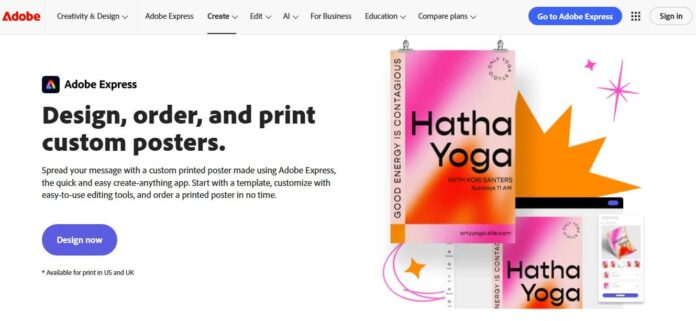Today’s customers are focusing more about sustainability and environmental health than ever before, so both companies and independent artists are finding creative ways to design and distribute their posters in all the ways to produce less waste. What once meant hefty waste and heavy environmental impact is now shifting, thanks to breakthroughs in greener printing technologies.
The usage of recycled stock and plant‑based inks, eco‑minded poster production has gone from just a mind thought to mainstream expectation. Even solo entrepreneurs and small teams (who might normally DIY their promotional flyers) are now able choose from thousands of free, customizable poster layouts online and print them in an earth‑friendly way. That makes free printable poster templates simpler than ever to marry artistic vision with a genuine commitment to protecting our planet.
In the following sections, we are going to share how these green printing methods are reshaping the poster business, how they benefit the environment and practical steps you can carry on to make your own prints more sustainable.
Why Sustainable Printing Is So Important
Traditional printing methods have long depended on materials and approaches that strain or damage the environment. Here’s a quick rundown:
Excessive paper use: Each year, countless trees are cut just to feed printing presses.
Toxic ink formulas: Conventional petroleum‑derived inks tend to emit harmful volatile organic compounds (VOCs).
High water and power demands: Large‑scale printing facilities guzzle both resources during production.
Non‑recyclable finishes: Glossy coatings and laminates often spoil recyclable paper.
As worries over climate change and resource depletion grow, both consumers and businesses have opt for cleaner options. In response, print providers have introduced smarter processes and materials that cut waste and emissions, all without sacrificing the look and feel you expect from high‑quality posters.
Key Aspects of Eco-Friendly Poster Production
Green poster printing goes far beyond just using recycled paper. It’s a complete, tip-to-toe approach that tackles every stage of production:
1. Recycled or FSC‑Certified Paper
The very base of any poster is the paper it’s printed on. By opting for paper that’s either certified by the Forest Stewardship Council or made from post‑consumer waste, you ensure the raw material comes from responsibly managed forests or recycling streams.
- Recycled paper helps cut down the need for fresh timber.
- FSC certification means forests are harvested in a way that’s ethical and guarantees new trees will be replanted.
2. Soy or Vegetable‑Based Inks
Instead of using conventional petroleum‑derived inks, green printers choose inks made from soy or other vegetable oils. These inks:
-Break down naturally over time (Biodegradable)
-Emit fewer volatile organic compounds (VOCs)
-Make recycling simpler
-Plus, they often give your posters richer, more vivid colors!
3. Energy‑Efficient Machinery
Today’s eco‑conscious print studios invest in printers and other equipment designed to use less electricity. Some facilities itself are powered by solar panels, further shrinking its carbon footprint.
4. Less Water Consumption
Traditional offset printing relies on water to regulate ink flow, but waterless techniques dispense with dampening systems altogether. That means less wasted ink and fewer harmful chemicals in the process making it savior in many ways.
5. Reduced Packaging
Eco-friendly printers aim to minimize packaging materials and choose biodegradable or easily recyclable packing to keep extra trash out of landfills when shipping.
How Eco‑Friendly Posters Help Brands and Artists
Embracing green printing is not just a morally right choice; it can actually strengthen your brand’s reputation by;
Building Trust: Today’s consumers pay more attention to a brand’s environmental credentials than their promises made by themselves.
Standing Out Your Message: An eco‑conscious poster pops amid a sea of standard, eliminating non eco-friendly ads.
Engaging Young Generation: According to an IBM/NRF study, about 64% of Gen Z say a company’s green policies shape their buying choices.
Cutting Costs Over Time: E-files, reusable templates, and precise printing help eliminate waste and make every investment count.
For designers, starting with templates visioned for eco‑friendly printing lets you stay stylish without compromising your values and beliefs.
Tips for Designing and Printing Eco-friendly Posters
Want to make your posters greener? Here’s a simple tip-sheet:
- Pick Simple Layouts: Designs with plenty of blank background space and limited color blocks use less ink.
- Print Locally: Choosing a nearby, eco‑certified printing vender cuts down on fuel used for shipping.
- Offer Digital Versions: Wherever possible, share a downloadable PDF instead of (or alongside) a printed copy.
- Print Smart: Only print what’s needed; on‑demand digital printing can help virtually eliminate leftover stock.
- Encourage Recycling: Add a small note telling viewers how to properly recycle or repurpose the poster afterward to introduce an eco-friendly solution to ignorance.
The Green Prospects for Poster Printing
Sustainability in printing is not going to lose it’s value, instead it’s expected to save the environment. With breakthroughs in materials, smarter machines, and growing public awareness, eco‑friendly poster production is fast becoming the standard. Whether you’re ordering a batch for a campus event or crafting your own design using free, green‑friendly templates, there’s never been a better time to compliment our planet.
Make your message shine while leaving only a light ecological footprint behind to strain our precious earth less.



